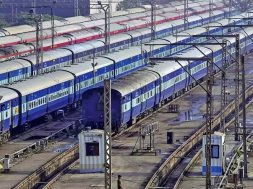Wind has almost reached grid parity rate where other clean sources are yet to reach. Continued support from the Government will further provide impetus for growth and make India a much greener place
Needless to say, the Indian power sector is at a stage crippled with finances witnessing shortfall in raw material procurements. Adding to woes is the policy paralysis that has led to severe bottlenecks in the sector. The rise in the price of imported coal and the shortage of the fossil fuel at home has given rise to a scenario that the Government is finding it almost impossible to cope up with.
With future looking bleak in conventional power, need of the hour is for cleaner and greener source of energy. Depleting fossil fuel and rising conventional power costs are contrasting the enormous potential lying untapped within renewable energy sector in India. Since power cost of conventional plant is increasing we will soon see green energy become at par or cheaper in coming years making cost of living sustainable for everyone.
India plans to add 76,000 MW capacity in its 12th Five Year Plan, with share of renewable at around 30,000 MW. Out of this, wind alone is expected to contribute 50 per cent in clean energy. By 2020, nearly 15 per cent of the power generated in India will be through renewable sources. As on 31st March 2012, India had an installed power generation capacity of 199.63 GW, out of which 25 GW accounted for green energy, with 17.6 GW coming from wind power alone.
India marked a record capacity addition of 3,019 MW through wind power for the first time in 2011, emerging 3rd in rank for new installations after China and US, driven by major incentives provided by the Government. However, wind installations are expected to fall short of target in the next fiscal as the Government has discontinued the accelerated depreciation (AD) benefit to the wind sector. AD was introduced in 1991 to attract capacity additions and gain technology stronghold when the wind industry was at a premature stage. However, it is a temporary setback and its impact will be short term. New capacity additions will be affected in the near term, and will also change the nature of the investor. The current investor base largely comprises of small size investments made primarily with the intent of availing tax breaks. The focus will now shift to setting up of large wind farms. The industry will consolidate in the near future as managing small capacities becomes unviable.
Now, in the absence of the AD benefit, the sector players have been demanding for the restoration of GBI scheme atleast until the 4,000 MW ceiling is reached. Under the ‘GBI scheme’, wind power generators were given an incentive of 50 paisa per unit, subject to a cap of Rs 62.5 lakh per MW of installed capacity. The scheme was to cease if the total capacity under it came to 4,000 MW or by March 31, 2012, whichever comes earlier.
The emergence of wind IPPs on the Indian energy landscape has resuscitated the investment rationale for the sector. The sector has undergone a paradigm shift from non-specialist organisations entering the space to reap benefits of tax legislation to specialised wind developers who base their strategies on improved incentive structures and better asset economics, thus making it a strong investment case.
Wind is the fastest growing renewable energy sector in the country. India ranks 5 globally in wind power generation at 17.6 GW, while China occupies the top position at a total installed capacity of 62.7 GW. India’s total wind power potential has been assessed at 60 GW. With a vast coastline of over 7,517 km, the potential in the sector remains highly unutilised. This unexploited resource has the potential to sustain the Indian energy sector fin the years to come.
Being the most environment-friendly, wind has proven to be the most viable source both commercially and operationally. It is the cheapest source of power, providing a permanent shield against depleting finite resources and ever increasing costs for conventional power. Unlike in conventional plants, the construction time and cost for wind farms is far less. There is no fuel costs associated. For setting up a typical wind farm of 1 MW, the average capital cost may range from Rs 5.5 crore to Rs 6.5 crore depending on various other factors. In India, the state of Tamil Nadu accounts for maximum wind power generation followed by Maharashtra, Gujarat, Karnataka and Rajasthan. Period between April to October accounts for 80 per cent of the generation with an average plant load factor (PLF) ranging between 25-30 per cent. The only drawback could be attributed to the seasonal nature of wind that cannot be produced 365 days in a year unlike other conventional routes.
Favourable policies and fiscal incentives like issuance of Renewable Energy Certificates based on Renewable Purchase Obligation (RPO) by each power distribution companies/captive power producers/power importers under open access etc. and trading thereafter on IEX/PXIL to realise the market determined price, accelerated depreciation or cash subsidy under generation based incentives by MNRE in lieu of accelerated depreciation, viable feed-in tariffs have helped boost the sector to a large extent. With right regulatory frameworks in place, tariffs from wind will always remain superior compared to other conventional sources. Moreover, the industry extends its effort in reducing carbon emissions under the UNFCC’s Clean Development Mechanism. Wind has almost reached grid parity rate where other clean sources are yet to reach. Continued support from the Government will further provide impetus for growth and make India a much greener place.
Growing awareness in the sector has seen substantial equity participation from global players, making it an attractive investment destination. Of the total investment of $10.2 billion in renewable energy (a growth of 54 per cent over previous year), $4.6 billion was invested in wind energy last year. Venture capital and private equity companies made a comeback with about $ 400 million of investments in the sector. Independent Power Producers in the sector remained attractive destinations for PE funding from the likes of IFC and Goldman Sachs amongst many others. Investments are also flowing in as global power equipment manufacturers set up base in India.
However, certain issues like land acquisition, local area development, grid connectivity from wind farms, obtaining statutory clearances, existence of regulatory bodies at Central as well as State level, needs to be immediately addressed. Though we have been able to harness our vast potential in on-shore generation, offshore wind remains unexplored, mainly due to high capital costs and unavailable supply chain. At present, Europe is the only continent to have developed its off-shore capacity in wind generation. There is also ample scope to explore areas with low wind regimes and re-developing brown-field projects or re-powering old turbines.
Being seasonal and hence intermittent in nature, wind farm developers are looking at huge investments in R&D to make wind a viable source of energy throughout the year. In such a scenario, proper wind forecasting can aid the sector significantly. For affordable transition from conventional power to wind power, infrastructural support is a must. For wind power to take off nationwide, transmission capacity to evacuate wind power needs to be increased substantially. The sector would require the Central/State Government’s support to create appropriate financial structures, sufficient grid/evacuation infrastructure and implementation of open access.
With India committed to increase the share of renewable power in the electricity mix to 15 per cent by 2020, the government has readied an action plan that aims at accelerating the deployment of renewable energy to achieve around 30 GW of renewable power by 2017. The Central Electricity Authority has projected a peak shortage of 12.9 per cent during 2011-12; and rapid scale up of wind power generation can only help bridge this gap to some extent.
AuthorPP Gupta, MD, Techno Electric and Engineering Company Limited
5
Cookie Consent
We use cookies to personalize your experience. By continuing to visit this website you agree to our Terms & Conditions, Privacy Policy and Cookie Policy.









